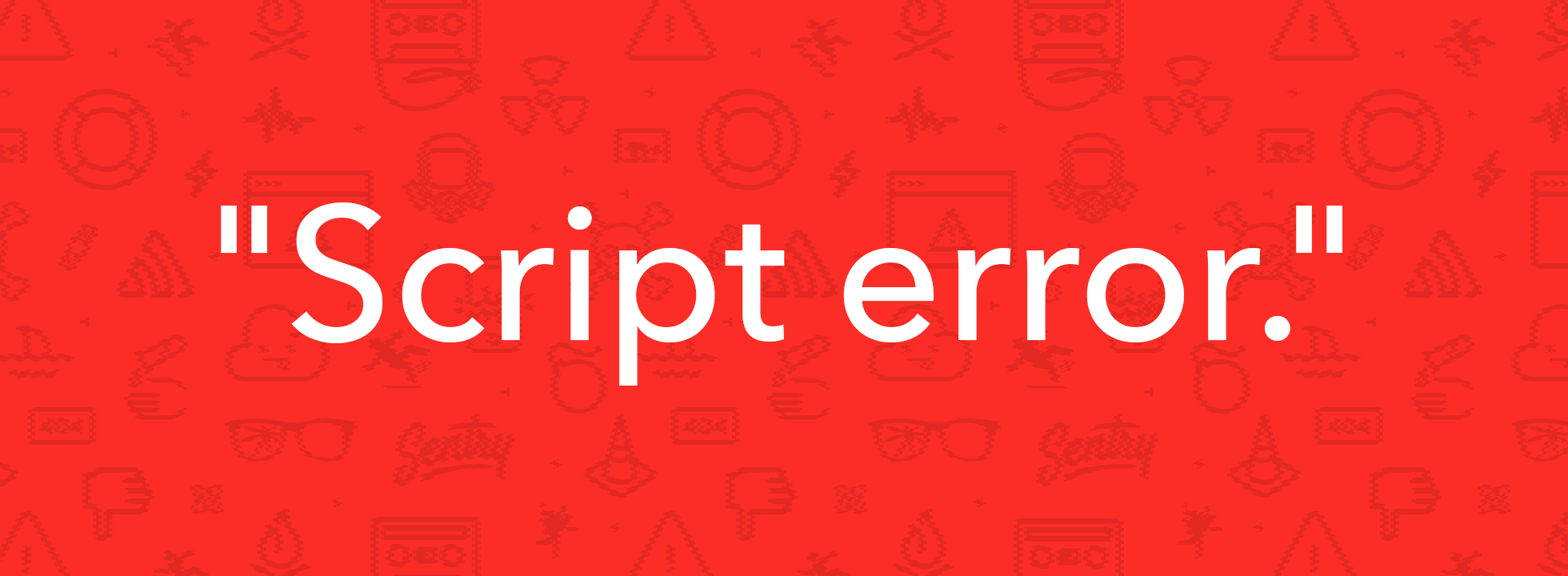【转】window.onerror跨域问题
What the heck is "Script error"?
 Ben Vinegar/ May 17, 2016
Ben Vinegar/ May 17, 2016

If you’ve done any work with the JavaScript onerror event before, you’ve probably come across the following:
"Script error."
“Script error” is what browsers send to the onerror callback when an error originates from a JavaScript file served from a different origin (different domain, port, or protocol). It’s painful because even though there’s an error occurring, you don’t know what the error is, nor from which code it’s originating. And that’s the whole purpose of window.onerror – getting insight into uncaught errors in your application.
The cause: cross-origin scripts
To better understand what’s going on, consider the following example HTML document, hypothetically served from http://example.com/test:
<!doctype html>
<html>
<head>
<title>example.com/test</title>
</head>
<body>
<script src="http://another-domain.com/app.js"></script>
<script>
window.onerror = function (message, url, line, column, error) {
console.log(message, url, line, column, error);
}
foo(); // call function declared in app.js
</script>
</body>
</html>Here’s the contents of http://another-domain.com/app.js. It declares a single function, foo , whose invocation will always throw a ReferenceError.
// another-domain.com/app.js
function foo() {
bar(); // ReferenceError: bar is not a function
}When this document is loaded in the browser and JavaScript is executed, the following is output to the console (logged via the window.onerror callback):
"Script error.", "", 0, 0, undefined
This isn’t a JavaScript bug – browsers intentionally hide errors originating from script files from different origins for security reasons. It’s to avoid a script unintentionally leaking potentially sensitive information to an onerror callback that it doesn’t control. For this reason, browsers only give window.onerror insight into errors originating from the same domain. All we know is that an error occurred – nothing else!
I’m not a bad person, really!
Despite browsers’ good intentions, there are some really good reasons why you want insight into errors thrown from scripts served from different origins:
- Your application JavaScript files are served from a different hostname, e.g. static.sentry.io/app.js.
- You are using libraries served from a community CDN, like cdnjs or Google’s Hosted Libraries.
- You’re working with a commercial 3rd-party JavaScript library, that is only served from external servers.
But don’t worry – getting insight into a JavaScript error served by these files just needs a few simple tweaks.
The fix: CORS attributes and headers
In order to get visibility into a JavaScript exception thrown from scripts originating from different origins, you must do two things.
1) Add a crossorigin=”anonymous” script attribute
<script src="http://another-domain.com/app.js" crossorigin="anonymous"></script>This tells the browser that the the target file should be fetched “anonymously”. This means that no potentially user-identifying information like cookies or HTTP credentials will be transmitted by the browser to the server when requesting this file.
2) Add a Cross Origin HTTP header
Access-Control-Allow-Origin: *CORS is short for “Cross Origin Resource Sharing”, and it’s a set of APIs (mostly HTTP headers) that dictate how files ought to be downloaded and served across origins.
By setting Access-Control-Allow-Origin: *, the server is indicating to browsers that any origin can fetch this file. Alternatively, you can restrict it to only a known origin you control, e.g.
Access-Control-Allow-Origin: https://www.example.comNote: most community CDNs properly set an Access-Control-Allow-Origin header.
$ curl --head https://ajax.googleapis.com/ajax/libs/jquery/2.2.0/jquery.js | \
grep -i "access-control-allow-origin"
Access-Control-Allow-Origin: *Once both of these steps have been made, any errors triggered by this script will report to window.onerror just like any regular same-domain script. So instead of “Script error”, the onerror example from the beginning will yield:
"ReferenceError: bar is not defined", "http://another-domain.com/app.js", 2, 1, [Object Error]
Boom! You’re done – ”Script error” will plague you and your team no more.
An alternative solution: try/catch
Sometimes, we’re not always in a position to be able to adjust the HTTP headers of scripts our web application is consuming. In those situations, there is an alternative approach: using try/catch.
Consider the original example again, this time with try/catch:
<!-- note: crossorigin="anonymous" intentionally absent -->
<script src="http://another-domain.com/app.js"></script>
<script>
window.onerror = function (message, url, line, column, error) {
console.log(message, url, line, column, error);
}
try {
foo(); // call function declared in app.js
} catch (e) {
console.log(e);
throw e; // intentionally re-throw (caught by window.onerror)
}
</script>For posterity, some-domain.com/app.js once again looks like this:
// another-domain.com/app.js
function foo() {
bar(); // ReferenceError: bar is not a function
}Running the example HTML will output the following 2 entries to the console:
=> ReferenceError: bar is not defined
at foo (http://another-domain.com/b.js:2:3)
at http://example.com/test/:15:3
=> "Script error.", "", 0, 0, undefined
The first console statement – from try/catch – managed to get an error object complete with type, message, and stack trace, including file names and line numbers. The second console statement from window.onerror, once again, can only output “Script error.”
Now, does this mean you need to try/catch all of your code? Probably not – if you can easily change your HTML and specify CORS headers on your CDNs, it is preferable to do so and stick to window.onerror.
But, if you don’t control those resources, using try/catch to wrap 3rd-party code is a surefire (albeit tedious) way to get insight into errors thrown by cross-origin scripts.
Note: by default, Raven.js – Sentry’s JavaScript SDK – carefully instruments built-in methods to try to automatically wrap your code in try/catch blocks. It does this to attempt to capture error messages and stack traces from all your scripts, regardless of which origin they’re served from. It’s still recommended to set CORS attributes and headers if possible.
If this blog post helped you out, and you’d like to learn more about window.onerror, you should also check out our other blog post: Capture and report JavaScript errors with window.onerror.


 浙公网安备 33010602011771号
浙公网安备 33010602011771号